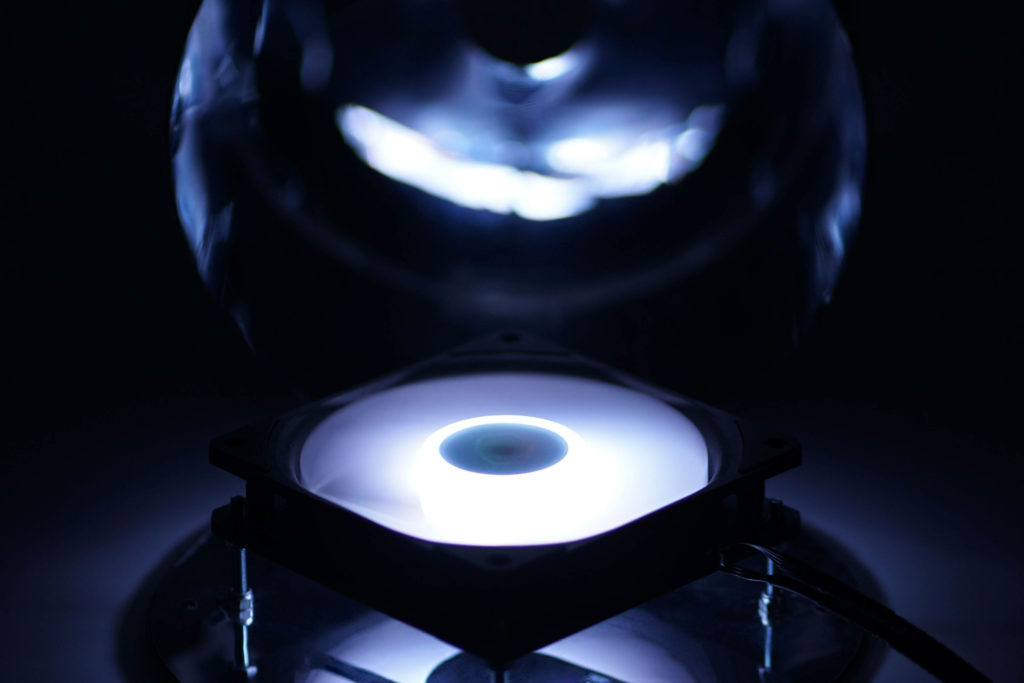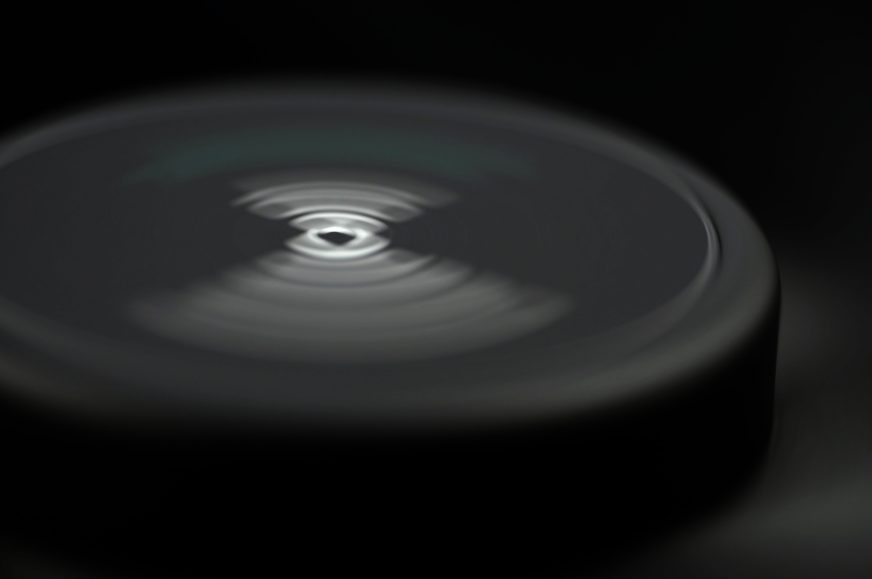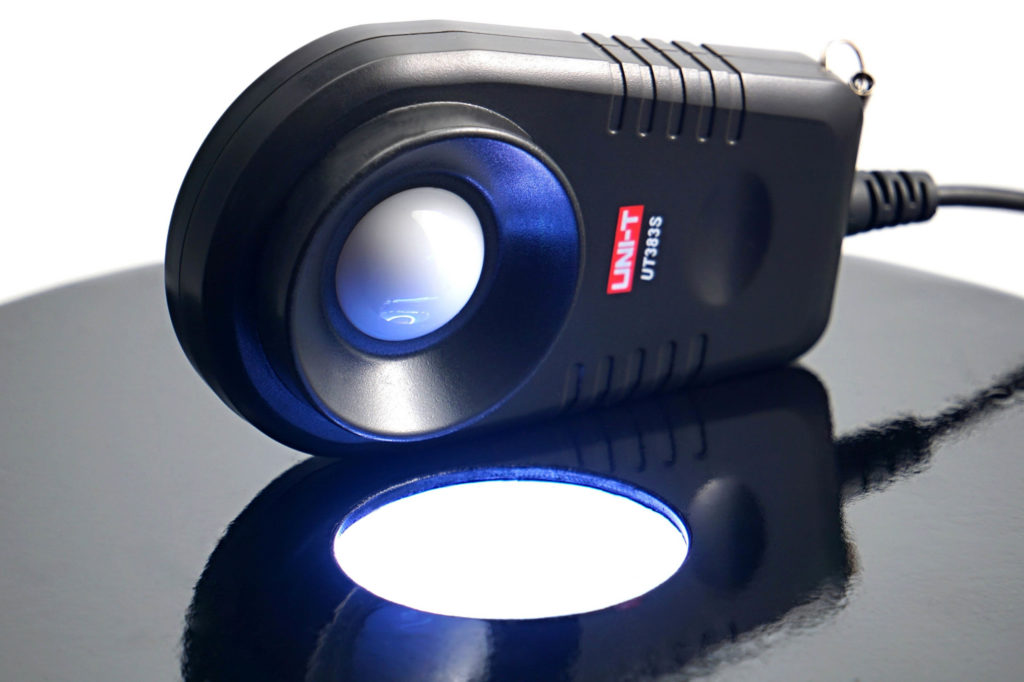Measuring the intensity (and power draw) of lighting
It is made in the same injection mould as the FC120, but still has noticeably better properties. Stronger material, higher weight, different bearings and a more powerful motor make the FK120 one of the most attractive options among inexpensive fans. But that’s only assuming the “right” adjustment. Outside of that, this fan can be quite uncomfortable and ironically for the same reason it is sometimes unbeatable.
Measuring the intensity (and power draw) of lighting
Modern fans often include lighting. This is no longer a “cooling” parameter, but for some users the presence of (A)RGB LEDs is important. Therefore, we also measure how intense this lighting is in our tests. These tests are the only ones that take place externally, outside the wind tunnel.
We record the luminosity of the fans in a chamber with reflective walls. This internal arrangement is important to increase the resolution for us to measure anything at all with lower luminosity fans. But also so that the readings do not blend together and it is obvious which fan is emitting more light and which one less.

The illumination intensity is measured in the horizontal position of the fan, above which is the lux meter sensor (UNI-T UT383S). This is centered on the illumination intensity sensing chamber.
The illumination is controlled via an IR controller and the hue is set to RGB level 255, 255, 255 (white). We record the brightness at maximum and minimum intensity. According to this, you can easily see if the brightness is high enough, but conversely also if the lower level is low enough for you.
In addition to the brightness intensity, we also measure the power draw that it requires. This is again through the shunt, which is between the Gophert CPS-3205 power supply and the (A)RGB LED driver. After this we get a reading of the lighting power draw. In the graphs we show it separately, but also in sum with the motor power draw as the total maximum fan power.
- Contents
- DeepCool FK120 in detail
- Basis of the methodology, the wind tunnel
- Mounting and vibration measurement
- Initial warm-up and speed recording
- Base 6 equal noise levels…
- ... and sound color (frequency characteristic)
- Static pressure measurement…
- … and airflow
- Everything changes with obstacles
- How we measure power draw and motor power
- Measuring the intensity (and power draw) of lighting
- Results: Speed
- Results: Airlow w/o obstacles
- Results: Airflow through a nylon filter
- Results: Airflow through a plastic filter
- Results: Airflow through a hexagonal grille
- Results: Airflow through a thinner radiator
- Results: Airflow through a thicker radiator
- Results: Static pressure w/o obstacles
- Results: Static pressure through a nylon filter
- Results: Static pressure through a plastic filter
- Results: Static pressure through a hexagonal grille
- Results: Static pressure through a thinner radiator
- Results: Static pressure through a thicker radiator
- Results: Static pressure, efficiency by orientation
- Reality vs. specifications
- Results: Frequency response of sound w/o obstacles
- Results: Frequency response of sound with a dust filter
- Results: Frequency response of sound with a hexagonal grille
- Results: Frequency response of sound with a radiator
- Results: Vibration, in total (3D vector length)
- Results: Vibration, X-axis
- Results: Vibration, Y-axis
- Results: Vibration, Z-axis
- Results: Power draw (and motor power)
- Results: Cooling performance per watt, airflow
- Results: Cooling performance per watt, static pressure
- Airflow per euro
- Static pressure per euro
- Results: Lighting – LED luminance and power draw
- Results: LED to motor power draw ratio
- Evaluation










Thank you so much for your hard work bringing us these reviews!
Greetings from Brazil!
Hello
Your expert explanation helped me make my final choice between the two DeepCool FK120 fans and the ASUS ROG Strix fan XF120.
The price difference of these two fans in Iran is insignificant and is around 5 dollars.
Overall, according to your tests, I would choose the Deep Cool fan.
I hope it is the right choice.
Your friend from Iran
Choosing the most suitable fan for a specific scenario is highly complex. In addition to the fact that all situations in practice are more or less different, each has a different set of priorities of individual characteristics. Someone may prefer lower vibrations to a slightly higher airflow, so that the fan does not end up being a source of excessive secondary noise in interaction with, for example, the case.
But when you have looked through our tests, taken a look at the context, evaluated the pros and cons, you must have made the right decision. 🙂
it would be more complex if we had more high quality fans on the market, but nowadays it’s mostly limited to whether you want maximum performance without noise or maximum performance disregarding the noise
in the first case you get A12x25 (or T30 if you have space for that), in the other probably some monster from Delta
if we had high quality fans optimized for specific usecases (like Noctua had in older generations, before releasing the overwhelmingly good A12x25) we could extend that choice to low vs high impedance, but nowadays S12A is entirely irrelevant and their static pressure fans are only used to save money